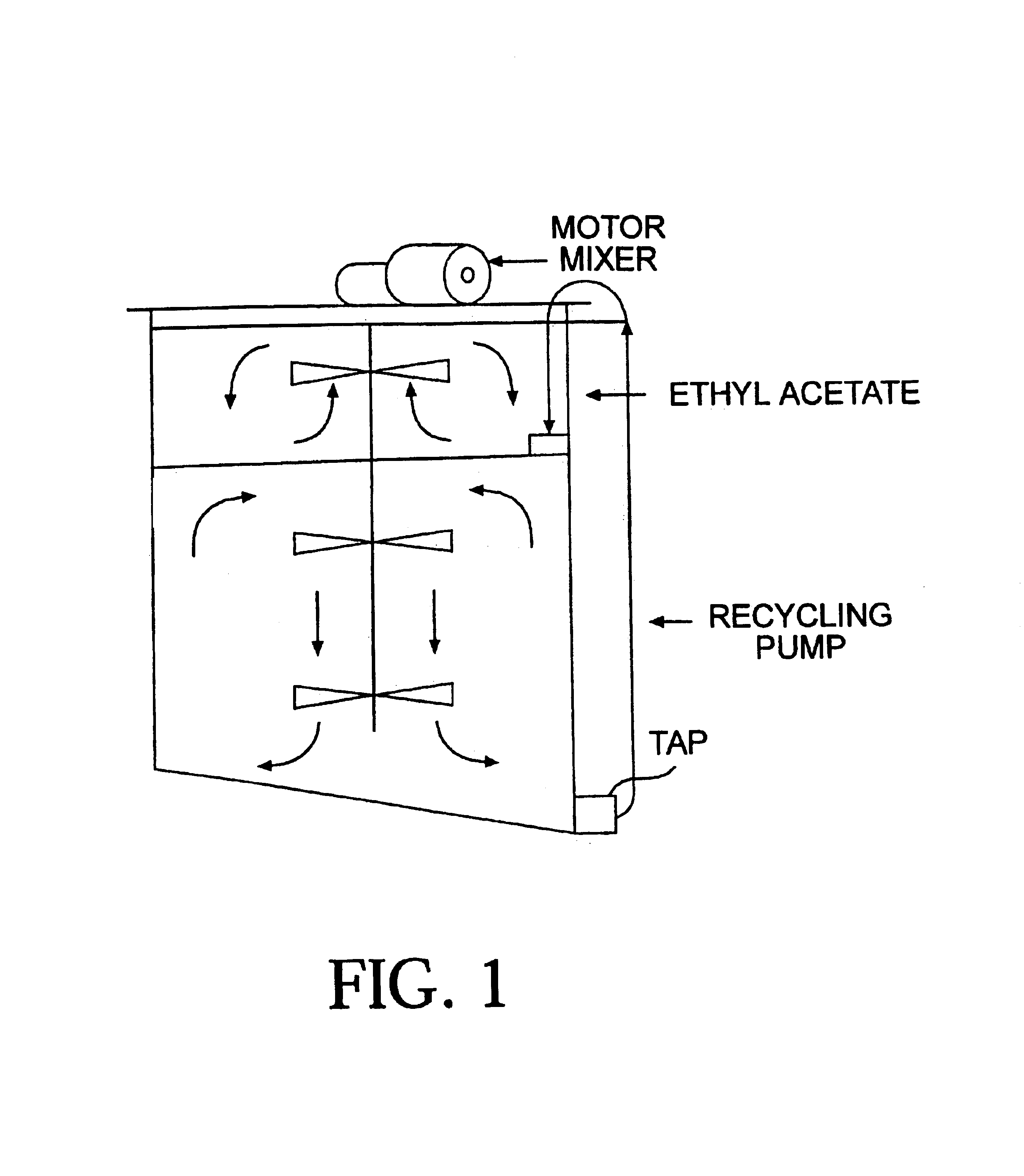Isoflavone compositions produced from legumes
a technology of isoflavone composition and legume, which is applied in the direction of plant/algae/fungi/lichens, peptides, biocide, etc., can solve the problems of high cost of hydrolysing enzymes, comparatively low yield of isoflavones, and multiple steps
- Summary
- Abstract
- Description
- Claims
- Application Information
AI Technical Summary
Benefits of technology
Problems solved by technology
Method used
Image
Examples
example 1
[0035]2000 kg of defatted soyflour is placed in a 10,000 L vessel as depicted in FIG. 1 containing 5,000 L of deionised water and 10 kg of β-glucanase / b-xylanase (Bio-Feed Beta CT; Novo Nordisk, Denmark). 1000 L of ethyl acetate is then layered on top of the aqueous suspension to give a two phase combination. Both aqueous and solvent phases are gently mixed by continuous stirring using a vertical propeller mixer (FIG. 1). It is found that the point of contact between the aqueous and organic solvent phases, the aglucone isoflavones readily move from the aqueous to the organic solvent phase. The constant agitation of the aqueous phase is designed to ensure maximum exposure of the hydrolysed isoflavones to the ethyl acetate; the constant agitation of the ethyl acetate helps to ensure a high isoflavone concentration gradient between the two phases, thereby maximising the rate of dissolution of the water-insoluble aglucone form into the ethyl acetate. An optional further contact between ...
example 2
[0038]The starting material is 200 kg of soy grits containing a mixture of soy hypocotyls and pieces of soy cotyledons and representing a more enriched source of isoflavones (about 10.% compared to about 0.2% on whole soyaflour). 200 kg of soy grits is placed in a 3000 L vessel containing 1000 L of deionised water and 2.5 kg of glucan hydrolase (Bio-Feed Beta CT; Novo Nordisk, Denmark). 1000 L of ethyl acetate is then added and the aqueous and solvent phases then mixed together vigorously using a pump with a capacity of about 200 L per minute to ensure effective contact between the two phases, that is, form an emulsion. The mixing continues at room temperature for a period of between 1-24 hours, but preferably 4 hours. The particulate material in this combination is then separated from the liquid phase by a standard process such as filtration or centrifugation. The removal of the particulate material destroys the emulsion, and on allowing the resulting liquid phase to stand for abou...
example 3
[0039]The dried end product of Examples 1 and 2 above (Sample 1) can be used as starting material to concentrate genistein or daidzein with / without glycitein. 3 kg of this material is mixed with 1000 L of an organic solvent such as acetone, chloroform or octanone, but preferably acetone for reasons of safety and cost. Each of these 3 solvents has been shown by the inventors to have high affinity for genistein but not daidzein or glycitein. The mixture is stirred continuously at room temperature for between 1-24 hours but preferably 2 hours during which time a large amount (approximately 75%) of the genistein transfers into the solvent phase. The mixture is allowed to settle for about 2 hours, the solvent separated from the residue (Sample 2) and transferred to a still for evaporation. The residue left after evaporation of the solvent (Sample 3) contains genistein at a purity of between 90-94% (mean 92%), with the residual material being daidzein and glycitein. Sample 2 material pref...
PUM
| Property | Measurement | Unit |
|---|---|---|
| temperatures | aaaaa | aaaaa |
| temperature | aaaaa | aaaaa |
| time | aaaaa | aaaaa |
Abstract
Description
Claims
Application Information
 Login to View More
Login to View More - R&D
- Intellectual Property
- Life Sciences
- Materials
- Tech Scout
- Unparalleled Data Quality
- Higher Quality Content
- 60% Fewer Hallucinations
Browse by: Latest US Patents, China's latest patents, Technical Efficacy Thesaurus, Application Domain, Technology Topic, Popular Technical Reports.
© 2025 PatSnap. All rights reserved.Legal|Privacy policy|Modern Slavery Act Transparency Statement|Sitemap|About US| Contact US: help@patsnap.com

